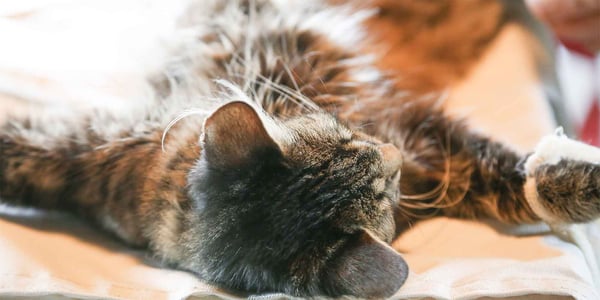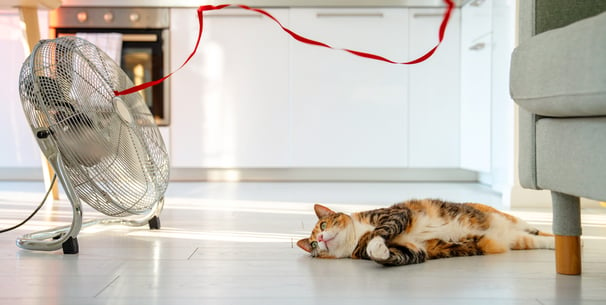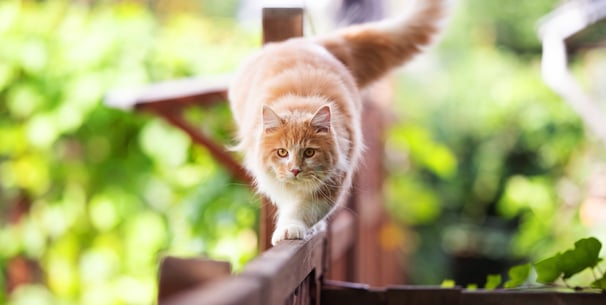Cat in Heat - How to Tell if Your Cat Is Coming Into Season
Index:



Introduction
Did you know that unspayed female cats, once they reach sexual maturity, are known as "seasonally polyestrous" animals? This means they experience multiple cat heat cycles throughout the breeding season, which typically occurs in the spring and summer months, or when daylight hours increase. During this time, they exhibit various behavioural and physical changes to attract potential mates.
Understanding this kind of behaviour is crucial for several reasons. Mainly because it allows pet parents to recognise the signs of heat in their cat, which can be helpful in preventing unwanted mating and subsequent pregnancies, potentially leading to an unexpected litter of kittens.
It also helps owners to provide the necessary care and support for their cats during this time. Cats in heat can experience discomfort and heightened anxiety. Being aware of these changes allows owners to create a soothing and stress-free environment for their cats, perhaps by providing a heating pad for comfort or keeping the litter box clean to avoid potential urinary tract infections.
If you want to help your cat in heat, you’ve come to the right place. We’re here to help you understand all things feline, more specifically, how to tell if your cat is in heat and how to best support them. Interested in finding out more? Read on.
What is a cat in heat?



When we refer to a cat being "in heat," we’re describing a period in an unspayed female cat's reproductive cycle, when she is sexually receptive and actively seeking a mate.
This fertile period is also known as the “estrus” stage of the estrous cycle. During this time, a cat may display a range of common signs to attract potential male mates.
These changes can include:
Increased vocalisation
Restlessness
Rubbing against objects or people
Rolling on the floor
Assuming a mating posture with her rear end raised and tail held to the side
Increased appetite
More affectionate behaviour towards owners
It’s also worth noting that cats in heat can display other changes in behaviour, such as increased agitation around cat flaps during the mating season.
The feline reproductive cycle consists of several stages, including proestrus, estrus, metestrus, and anestrus. Proestrus is the initial stage, where the female cat starts preparing for mating. During this time, she may exhibit signs of restlessness and increased affection towards her owner.
Estrus, commonly referred to as being "in heat," is the stage where the female cat is sexually receptive. This is the period when she is most likely to mate and conceive. When a cat mates during this period, the likelihood of her conceiving and producing a litter of kittens increases significantly.
Metestrus follows estrus and is a period of transition where the cat's body prepares for a potential pregnancy. If mating does not occur, the cat will enter anestrus, a period of sexual inactivity.
As mentioned above, cats are considered seasonally polyestrous, meaning they have multiple heat cycles within a breeding season. The breeding season for cats typically occurs in the spring and summer months.
The exact frequency of heat cycles can vary among individual cats, but on average, a female cat will go into heat every two to three weeks during the breeding season if not bred or spayed.
However, it's important to note that domesticated cats can experience heat cycles year-round, especially if they are exposed to artificial lighting and controlled indoor environments that mimic the conditions of the breeding season.
Signs that your cat is in heat



One of the biggest telltale signs your female cat is in heat is that she’ll just act a bit strange. You’ll typically notice she’s more vocal than usual and will cry at night looking to attract a mate. This is often paired with restlessness and low crawls along the floor. This isn’t a sign she’s in pain - it’s just what cats do. Lots of cats in heat also moan and growl as they crawl along the floor. Again, a bit strange to witness but it’s part of the heat cycle!
Some cats in heat also love to dish out extra TLC to their owners. If your cat isn’t usually affectionate but is suddenly rubbing herself against doorways, furniture, and yourself, this could be a huge indicator she’s in heat and wants to feel the love back from you so be sure to give her lots of strokes.
During the heat cycle, female cats often groom themselves a lot as they feel uncomfortable. Again, this is not typically something to worry about but if you think your cat is over-grooming or in pain, it’s worth getting a professional opinion from your vet.
Some owners struggle to keep their cats indoors during heat cycles as they want to make The Great Escape in search of a mate. This can be extremely worrying if your cat doesn’t go outside often and can also lead to unwanted and quite frankly, dangerous, pregnancies.
This is just one of the many reasons why veterinary professionals advise neutering and spaying your cats when they are at a suitable age. Cats in heat will also move their tails to assume a mating position and stick their bums in the air. Again, this can look a bit odd if she’s positioned herself by your favourite mid-century furniture.
Understanding the physiology of a cat in heat



When a cat is in heat, there are significant changes in hormonal levels that drive their reproductive behaviour. During the estrus phase, the hormone oestrogen is at its peak. This surge in oestrogen triggers physical and behavioural changes in the cat. It stimulates the release of eggs from the ovaries and prepares the reproductive tract for potential fertilisation.
Oestrogen also plays a role in triggering the characteristic behaviours associated with being in heat, such as increased vocalisation, restlessness, and rubbing against objects. Understanding the hormonal fluctuations that occur during a cat's heat cycle can provide insights into the physiological processes driving their reproductive behaviour.
Pheromones also play a vital role in a cat's heat cycle. Female cats in heat release specific pheromones that act as chemical signals to attract male cats. These pheromones are typically emitted through the cat's urine and can linger in the environment, signalling their reproductive status to potential mates. Male cats, in turn, can detect these pheromones, often from a considerable distance, and may exhibit behavioural changes such as increased vocalisation and roaming in search of a receptive female. Pheromones act as a means of communication between cats, facilitating the mating process and enabling successful reproduction.
The estrus cycle consists of various phases that occur when a cat is in heat. The proestrus phase is the initial stage, characterised by preparatory changes in the female cat's reproductive system. During this phase, the cat may display subtle signs of restlessness and increased affection towards their owners.
The estrus phase follows, during which the female cat is sexually receptive and actively seeking a mate. This is when the distinct behavioural changes associated with being in heat, such as calling, rolling, and displaying the mating posture, are most apparent.
If mating and fertilisation occur, the cat enters the metestrus and potentially pregnancy. If not, the cat will eventually enter the anestrus phase, where sexual activity and reproductive behaviours cease until the next cycle begins.
Coping with a cat in heat
Providing a comfortable environment for a cat in heat is essential to help alleviate any discomfort and reduce stress. One way to create a comfortable environment is by ensuring a quiet and calm space for the cat. Limiting exposure to loud noises, unfamiliar visitors, or other stressful triggers can help reduce anxiety. Providing a cosy and secluded area with comfortable bedding can also give the cat a sense of security during this time.
Additionally, providing interactive toys, scratching posts, and engaging play sessions can help redirect their energy and keep them mentally stimulated. It's important to remember that each cat is unique, so observing their preferences and adjusting the environment accordingly can go a long way in providing comfort.
To avoid triggers and prevent unwanted pregnancy in a cat in heat, it's crucial to keep the cat indoors and away from intact male cats. This can be achieved by securely closing windows and doors, and using extra precautions to prevent escape.
Ensuring that the cat's litter box is clean and easily accessible can also help reduce stress and eliminate any potential discomfort during this time. If there are other cats in the household, separating them temporarily can prevent unwanted mating. Spaying or neutering the cat is an effective long-term solution to prevent heat cycles and eliminates the risk of unplanned pregnancies.
How to calm a cat in heat



To calm a cat in heat, consider using a combination of natural remedies and medical interventions. Natural remedies include creating a soothing environment with quiet spaces and comfortable bedding, using pheromone diffusers or sprays designed to reduce stress, and engaging your cat in interactive play or providing puzzle toys to redirect their energy.
A veterinarian may recommend medical interventions such as hormone injections or oral medications to temporarily suppress heat cycles and alleviate associated symptoms.
Ultimately, it is essential to consult with a veterinarian to determine the most suitable approach to calm a cat in heat based on their individual needs and circumstances. If you’re a Waggel member, you can chat with a vet any time of the day by using Joii. It’s free and can help to ease stress and worry surrounding your pet’s health.
When to spay or neuter your cat



Spaying or neutering a cat offers numerous benefits for their health and well-being. It eliminates the risk of unplanned pregnancies, as touched upon above, ultimately preventing the challenges of caring for and finding homes for kittens.
Spaying or neutering also reduces the likelihood of certain reproductive cancers and eliminates the risk of uterine infections in female cats. In male cats, neutering can decrease roaming tendencies, aggression, and the urge to mark territory with urine.
Spaying or neutering can help manage behavioural issues related to mating behaviours such as excessive vocalisation or restlessness during heat cycles. The best time to spay or neuter a cat is typically around 4 to 6 months of age, but it can vary depending on your veterinarian's recommendation and your cat's overall health. It's important to consult with a veterinarian to determine the optimal timing for the procedure based on your individual cat's age, breed, and health status.
Dealing with the aftermath of heat



A cat's behaviour can change after they have been in heat. Once a female cat has completed her heat cycle, her behaviour may return to normal. She may become calmer and less restless compared to when she was actively seeking a mate. The intense vocalisation, rubbing against objects, and other mating behaviours associated with being in heat typically subside.
After the heat cycle, female cats may also experience a temporary period of sexual inactivity known as anestrus. During this time, they may display reduced interest in mating and exhibit less attention-seeking behaviour.
After spaying a female cat, her behaviour may undergo certain changes. One of the most noticeable changes is the absence of heat cycles, which eliminates the behaviours associated with seeking mates, such as yowling, for example.
Spayed cats are generally calmer and less prone to aggression. Without the influence of hormones, spayed cats are less likely to engage in territorial marking behaviours, including spraying urine.
Overall, spaying helps to reduce certain undesirable behaviours related to mating and reproductive instincts, allowing your cat to lead a more relaxed and contented life. However, it's important to note that individual variations in behaviour exist, and any significant changes should always be discussed with a veterinarian to ensure your cat's well-being.
Conclusion



There are lots of physical and behavioural changes that take place when a female cat is in heat. If you haven’t witnessed a heat cycle before, we understand why it can be kind of concerning! However, most cats often display similar behaviour types as they look for a mate and it’s nothing to worry about.
Understanding a cat’s heat cycle can help you to become more in tune with your pet and develop a closer bond. It can also help you to recognise the signs of a heat cycle, which can be helpful in preventing unwanted mating and subsequent pregnancies.
Spaying and neutering is the best way to avoid heat cycles and pregnancy entirely and can help your cat to feel more calm and comfortable in life. As always, if this is something you’re considering for your pet, speak directly to your vet who can provide expert advice.
In the meantime, if you’ve got more burning cat questions or queries, our blog is here to help. We’ve got posts on hypoallergenic cat food, what to do if your cat isn’t eating but acting normal, and how to treat ringworm.
And of course, if you’re looking for cat insurance, you’re in the right place. Our cat insurance guide is here to help you save money and get the most from your policy.
FAQs
What happens if I don't spay or neuter my cat?
If you don’t spay or neuter your cat you could be looking at multiple pregnancies which can be incredibly difficult for your cat. Unspayed female cats are also more likely to suffer from ovarian cysts and mammary cancer.
Can a cat in heat get pregnant from a neutered male?
Technically, yes. Although neutering sterilises male cats, they can still impregnate female cats for a few weeks post-surgery due to leftover sperm and hormones.
How long does a cat stay in heat?
On average a cat is usually in heat for around 7 days, though some heat cycles last for over 3 weeks.
Is it possible for a male cat to tell when a female is in heat?
Male cats can tell if a female cat is in heat by smelling her cheek glands or her pheromones which are found within her urine. Because cats have such a strong sense of smell, they often begin to exhibit mating behaviour even if the female cat isn’t present.
Waggel Pet Insurance
Need more help? You're in luck if you're a Waggel Pet Insurance member. Along with our excellent coverage, we offer access to a 24/7 online vet to answer all your sticky questions, especially if you need grooming assistance.
Not a member? Why not get a quote now and cover your furry friend for a range of illnesses, all while enjoying our amazing perks and rewards.
Want more like this?
Get updates from us with helpful info, advice, answers to frequently asked questions and much more.
Index:
Related posts:
Get your quote
Along with our excellent coverage, we offer access to a 24/7 online vet to answer all your sticky questions.





